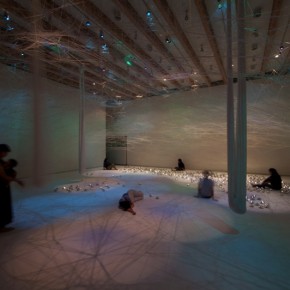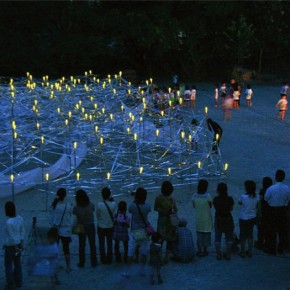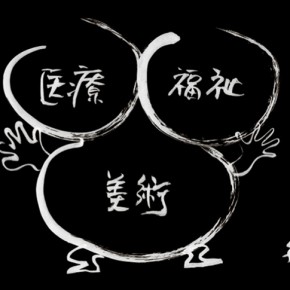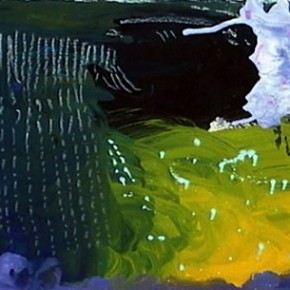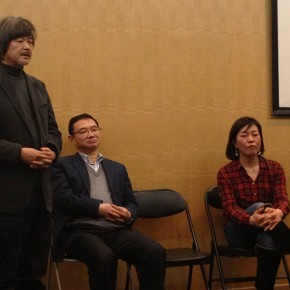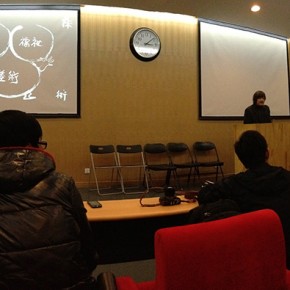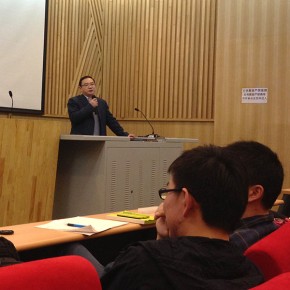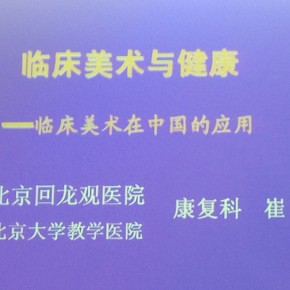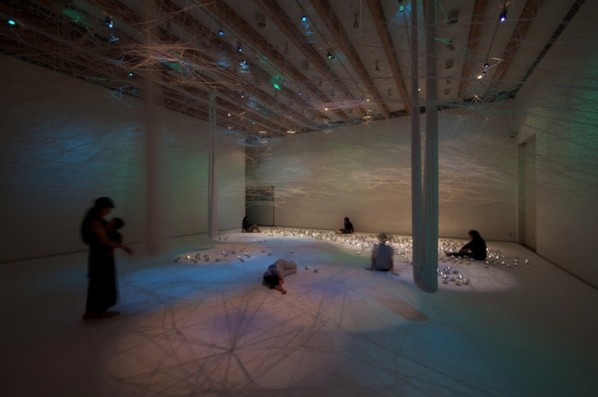
The lecture entitled Art • Welfare • Therapy: What the Interdisciplinary “Clinical Art” is?, by Kijyo Rokkaku Studio of CAFA, was held on the first floor of Red Chair Lecture Hall, Building 7, CAFA, at 15:00pm, Friday March 8, 2013, Kijyo Rokkaku(六角鬼丈), Distinguished Professor of the School of Architecture, CAFA, Chairman of Japan Clinical Art Association, Cui Yong, Director of the Rehabilitation Division of Beijing Hui Long Guan Hospital, Director of Chinese Mental Health Association, and Vice Director of the Chinese Music Therapy Association, Megumi Kyugen(宫元惠美), Associate Professor of the School of Design, Tokyo University of Technology, Doctor of the Faculty of Fine Arts, Tokyo University of Arts were invited to respectively present their lectures on three themes the “Overview of Clinical Art Practice”, “Clinical Art and Health - Application of Clinical Art in China”, and “Space for Children’s Creation”.
As the Chairman of the Japan Clinical Art Association, Kijyo Rokkaku initially introduced the nature of the Clinical Art Association as the operation of art creations which would benefit the community, and to call on the students that majored in arts to participate in the social activities in cooperation with the students of other majors. When asked why he participated in clinical art as an architect, he referred to the perception that the art museum project needs his participation, in fact, he had studied the relationships between human perception and architecture for a long time. He then introduced the concept of clinical art. The so-called clinical art was the art therapy courses independently developed, built on the basis of brain science, aiming to promote the activity of the brain function through creative activities such as painting and three-dimensional plastic, which initially started from a time research project in 1996, by a team composed of physicians, artists, and home carers. Its characteristics were beyond the entry point of the boundaries between various disciplines of therapy, art, and welfare, which were a combination that various people had seen in the developed countries with art therapy. It aimed to mitigate the cognitive impairment symptoms in the beginning, now it was also applied to the prevention of mild cognitive impairment and cognitive impairment of the elderly. In addition, it was well received by some professionals such as emotional education for the intellectual growth of children and welfare education. Clinical Art hopes that people who were not good at painting had fun with it, which set them free from the concepts of the good and bad, of the freedom of the expression of feelings, enjoying the fun in the process. In addition, he introduced the nurturing and activities of clinical art, for example, the Land Art Festival in Echigo-Tsumari Art Field.
Cui Yong, Director of the Rehabilitation Division of the Beijing Hui Long Guan Hospital, mainly overviewed the clinical art’s applications on “therapy”, included the therapy by viewing painting, the course of modern art therapy, theories of art therapy, the characteristics and role of art therapy, industrial associations of art therapy, history and practice of Chinese art therapy, etc. The focus of his speech was a supplement for the audience with a lot of knowledge of theories.
After a short break, Megumi Kyugen, an outstanding student of Kijyo Rokkaku brought more practical cases.
After graduation, she was destined for Germany and the United Kingdom to study, she came into contact with children’s activities, including Making Space with Children, a space construction activity for children, different from the clinical art while also overlapping. Starting from this experience, she gradually made the creation of a space for children a subject of study. Then she operated a variety of activities such as the Colour Friends, the Milky Way, Seven Stories of the Giraffe, Bliss and the exhibition of Sea Line 2012. During the introduction of these activities, she provided a lot of photos of the activities, so that the students present were immersed in the ideas. She gave a detailed description of the activities and shared her insight, she thought urban children were strictly constrained by traditional education, rarely involved in outdoor activities, at the beginning children always felt that they should learn something, after the activities, the nature of the kids came back.
Subsequently, Kijyo Rokkaku added: because of her professional background in architecture, together with children, she could create a space, which was closely related to a social communication in art. This form is related to clinical art. Rather than question the social system as an individual artist, it was better to explore a new form of communication with children. He suggested that artists, students of academies and staff in the medical field come together to participate in meaningful things. He hoped that the students of CAFA who were interested in it participated in this kind of project. Finally, he gave his sincere hanks to the teachers and students from the School of Architecture, as well as the students and teachers that were present.
Following by the section of Q & A
1 How to deal with the activity which was out of control?
Megumi Kyugen: It took three months to prepare an activity, firstly an idea, secondly feeling children’s characters during the communicating with them, and adjusting the program, then there are the changes and mishaps. Children’s views were often adopted and absorbed, so it would head in the general direction.
2 How did the parents look at the works?
Megumi Kyugen: Parents were not allowed to participate in the creative process, but invited to visit it after the course, and children explained the significance of the works to their parents, whose views about the works depended on the interpretation of children, rather than the teachers who organized the activity. It was at this time that the relationships between parents and children were swapped and changed. It was interesting that parents could listen to their children.
3 What knowledge was necessary for the nurturing of the clinical art? How to nurture?
Kijyo Rokkaku: Aesthetic was necessary for the staff of clinical art, some of them majored in art. They were neither doctors nor the welfare institution commissioners, they were the non-professionals oriented in the field of art. Although the result was practiced by medical detection, the process was in need of implementation by the person who knows art. The staff of clinical art were divided into five levels, within a strict regime. In fact, currently the Japanese economy was too bad for artists to earn a living, so many of them chose this career as a sideline.
The lecture ended after 18:00 with a successful conclusion. Some students said, the lecture gave them knowledge of a new professional field in art, and the latest developments in this regard, they hope that there would be more communications and displays in the future.
Text and photography by Li Pan, translated by Chen Peihua/ CAFA ART INFO


